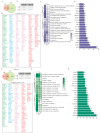Single-Cell Transcriptomic Profiling Reveals Regional Differences in the Prefrontal and Entorhinal Cortex of Alzheimer's Disease Brain
- PMID: 40429980
- PMCID: PMC12112128
- DOI: 10.3390/ijms26104841
Single-Cell Transcriptomic Profiling Reveals Regional Differences in the Prefrontal and Entorhinal Cortex of Alzheimer's Disease Brain
Abstract
Previous studies have largely overlooked cellular differential alterations across differentially affected brain regions in both disease mechanisms and therapeutic development of Alzheimer's disease (AD). This study aimed to compare the differential cellular and transcriptional changes in the prefrontal cortex (PFC) and entorhinal cortex (EC) of AD patients through an integrated single-cell transcriptomic analysis. We integrated three single-cell RNA sequencing (scRNA-seq) datasets comprising PFC and EC samples from AD patients and age-matched healthy controls. A total of 124,658 nuclei and 31 cell clusters were obtained and classified into eight major cell types, with EC exhibiting much more pronounced transcriptional alterations than PFC. Through network analysis, we pinpointed hub regulatory genes that form interconnected networks driving AD pathogenesis, findings validated by RT-qPCR showing more pronounced expression changes in EC versus PFC of AD mice. Moreover, dysregulation of the LINC01099-associated regulatory networks in the PFC and EC, showing correlation with AD progression, may present new therapeutic targets for AD. Together, these results suggest that effective AD biomarkers and therapeutic strategies may require simultaneous, precise targeting of specific cell populations across multiple brain regions.
Keywords: Alzheimer’s disease; cellular regulatory network; entorhinal cortex; prefrontal cortex; single-cell transcriptome sequencing.
Conflict of interest statement
The authors declare no conflicts of interest.
Figures







Similar articles
-
Sex-Stratified Single-Cell RNA-Seq Analysis Identifies Sex-Specific and Cell Type-Specific Transcriptional Responses in Alzheimer's Disease Across Two Brain Regions.Mol Neurobiol. 2022 Jan;59(1):276-293. doi: 10.1007/s12035-021-02591-8. Epub 2021 Oct 20. Mol Neurobiol. 2022. PMID: 34669146 Free PMC article.
-
Integration of Single-Cell and Spatial Transcriptomic Data Reveals Spatial Architecture and Potential Biomarkers in Alzheimer's Disease.Mol Neurobiol. 2025 May;62(5):5395-5412. doi: 10.1007/s12035-024-04617-3. Epub 2024 Nov 15. Mol Neurobiol. 2025. PMID: 39543008
-
Proteomic and Transcriptomic Analyses Reveal Pathological Changes in the Entorhinal Cortex Region that Correlate Well with Dysregulation of Ion Transport in Patients with Alzheimer's Disease.Mol Neurobiol. 2021 Aug;58(8):4007-4027. doi: 10.1007/s12035-021-02356-3. Epub 2021 Apr 27. Mol Neurobiol. 2021. PMID: 33904022
-
Transcriptional Networks of Microglia in Alzheimer's Disease and Insights into Pathogenesis.Genes (Basel). 2019 Oct 12;10(10):798. doi: 10.3390/genes10100798. Genes (Basel). 2019. PMID: 31614849 Free PMC article. Review.
-
Molecular mechanisms of neurodegeneration in the entorhinal cortex that underlie its selective vulnerability during the pathogenesis of Alzheimer's disease.Biol Open. 2021 Jan 25;10(1):bio056796. doi: 10.1242/bio.056796. Biol Open. 2021. PMID: 33495355 Free PMC article. Review.
References
-
- Kunkle B.W., Grenier-Boley B., Sims R., Bis J.C., Damotte V., Naj A.C., Boland A., Vronskaya M., van der Lee S.J., Amlie-Wolf A., et al. Genetic meta-analysis of diagnosed Alzheimer’s disease identifies new risk loci and implicates Aβ, tau, immunity and lipid processing. Nat. Genet. 2019;51:414–430. doi: 10.1038/s41588-019-0358-2. - DOI - PMC - PubMed
-
- Wingo A.P., Liu Y., Gerasimov E.S., Gockley J., Logsdon B.A., Duong D.M., Dammer E.B., Robins C., Beach T.G., Reiman E.M., et al. Integrating human brain proteomes with genome-wide association data implicates new proteins in Alzheimer’s disease pathogenesis. Nat. Genet. 2021;53:143–146. doi: 10.1038/s41588-020-00773-z. - DOI - PMC - PubMed
-
- Keren-Shaul H., Spinrad A., Weiner A., Matcovitch-Natan O., Dvir-Szternfeld R., Ulland T.K., David E., Baruch K., Lara-Astaiso D., Toth B., et al. A Unique Microglia Type Associated with Restricting Development of Alzheimer’s Disease. Cell. 2017;169:1276–1290.e1217. doi: 10.1016/j.cell.2017.05.018. - DOI - PubMed
MeSH terms
Substances
Grants and funding
LinkOut - more resources
Full Text Sources
Medical
Miscellaneous

